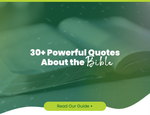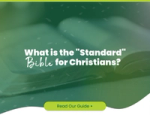'What's In The Bible?' - Ask A Child
Peter Harrison
‘What’s In The Bible?’ is a new DVD series that seeks to ‘walk children through the Bible from Genesis to Revelation, answering their big questions along the way’. It’s entertaining, theologically sound, and can be used flexibly from Sunday school to the sitting room.
Phil Vischer
Phil Vischer quite hilariously introduces himself on the ‘What’s In The Bible?’ advertisement as ‘Veggie Tales Creator, Phil Vischer’. Perhaps in Britain we are prejudiced against the use of such titles, but in this example a great function is served - Vischer is highly forgivable. By calling himself such a name he immediately relates to a target audience; 'Veggie Tales' is a world famous brand, renowned for its usability in teaching the Bible to children. Vischer notes the value of ‘Veggie Tales’ in teaching key themes and values, but moves on to talk excitedly about his latest project ‘What’s In The Bible?’.
This project, he says, is about addressing a serious problem faced by the western Church today - children often abandon their faith, walking away from God at the end of high school because their faith doesn’t have a solid foundation. Through teaching the whole Bible to children at an early age, a bigger picture can be grasped - no longer a bunch of stories, Sunday school is about the overarching and interconnected plan of God. The Bible is made understandable and relevant.
Buck Denver
The central protagonist of the exciting new project is Buck Denver - often donning a khaki explorer’s outfit, he convenes the adventures through the books of the Bible. Switching between the personas of an explorer and a news anchorman, Buck’s humorous narration and singing appeals strongly to children, who will remember and sing the catchy songs. Phil Vischer’s versatility as a voice actor is also displayed through Buck, who remains an audience favourite despite having an accent oddly similar that of Labour leader Ed Miliband.
'What's In The Bible?'
Here is a brief overview of the format of 'What's In The Bible?', its aims, and its intended audience.
Format
‘What’s In The Bible?’ is almost entirely animation, prominent characters are portrayed as puppets, while lesser characters appearing in only one or two episodes feature as 2-D animations.
Episodes are 25 minutes each, and are related directly to books in the Bible, starting with Genesis. With the release of the 7th DVD, books covered include Genesis through to Esther. Furthermore, there is a Christmas DVD ‘Why Do We Call It Christmas?’ and a number of DVDs catering directly towards Sunday school teaching have also been released. The full range is available on Eden.co.uk - just click the link to view the ‘What’s In The Bible?’ department.
Rather than being overly serious or patronisingly didactic, the ‘What’s In The Bible?’ DVDs approach Scripture in a light-hearted way, without taking away from the seriousness of the subject matter. Comedy is used as an effective means of communication to children.
Aims / Purpose
As touched on previously, ‘What’s In The Bible?’ intends to communicate the whole Bible to children, firmly establishing a knowledge and understanding of Scripture as one true and relevant story, not just a bunch of entertaining myths or legends.
Through communicating such a message, Phil Vischer hopes that this, his latest project, will be successful in building a foundation of faith in children from an early age. Obviously these DVDs will not work on their own - the input of parents and teachers on children is crucial too - but the DVDs provide an easier way to achieve memorable communication of the message of the Bible.
Granted, some churches could stage their own puppet shows retelling biblical stories, but doing this each week would be likely to become a drain on leaders energy, not to mention the expense. ‘What’s In The Bible?’ is a great alternative.
Audience
Reviews by those who have bought ‘What’s In The Bible?’ give a fairly wide estimate of the age range it appeals to. Children from aged 2 to 11 have reportedly enjoyed and engaged with the DVDs. Personally, I would suggest an optimum age range might be 4 to 9, but this may be stretched at either end.
The message of the Bible is explained, according to one reviewer, with ‘repetition and humour’ that helps to keep children engaged, while the message is emphasised. Covering more material in order to avoid any repetition could result in the message going over the heads of most young children. A happy balance is evident - the material isn't boring, nor is it over-complicated.
Outtro
Tired of the word ‘conclusion’ and its various connotations, this is the ‘outtro’. Hopefully this will serve to kickstart your own use of ‘What’s In The Bible?’ or your recommendation of the series to a friend who would find it useful.
Phil Vischer has endeavoured to reach children through video since 1990; his experience and talent shine through here as he effectively communicates the Word of God to children, with deep relevance to their everyday lives.
Latest Blogs

Bible
30+ Powerful Quotes About the Bible (For Inspiration in 2026)
Looking for inspiration? Discover a curated collection of the most powerful quotes about the Bible, from famous historical figures to modern theologians and Scripture itself.

Bibles
What is the "Standard" Bible for Christians?
Is there an "official" Bible that all Christians use? We explain the difference between the NIV, KJV, and ESV, and help you find the standard text for your church or personal reading.

Bible
"I Keep Failing to Read the Bible" – 5 Tips to Make the Habit Stick
Do you start a Bible reading plan only to quit a few weeks later? Stop the cycle of guilt. Here are 5 psychological tips and practical changes to help you build a Bible habit that actually lasts in 2026.

Bible
Where to Start Reading the Bible (5 Great Books for Beginners)
Confused about where to start reading the Bible? Don't start at page one! Here are the 5 best books for beginners to start with, from the action of Mark to the wisdom of Proverbs.

Bible
How to Start Reading the Bible for the First Time
Feeling overwhelmed by the Bible? You are not alone. Here is a simple, jargon-free guide on where to start, which translation to choose, and how to make sense of it all.

Bible
How to Read the Bible in a Year (A Simple 15-Minute Daily Plan)
A practical breakdown showing that reading the entire Bible in a year requires only 15 minutes a day, with tips on how to fit this simple habit into your daily routine.
